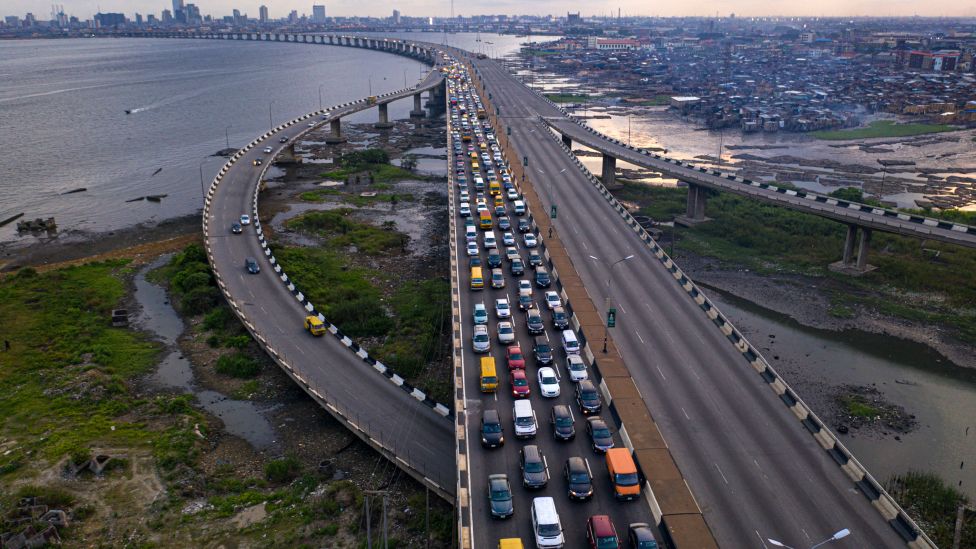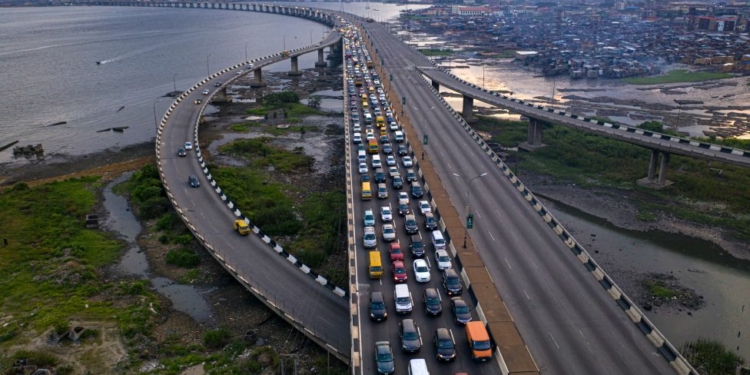Ever wondered about the history of that iconic bridge you cross whenever you’re headed to the mainland or island in Lagos? The Third Mainland Bridge is one of the most important landmarks in Nigeria’s largest city, connecting Lagos Island to the mainland. You’ve probably spent countless hours sitting in traffic on it, but how much do you actually know about how it came to be?
Before it was built, the only way to get across Lagos Lagoon was by ferry or a long circuitous route. The 11.8 km bridge took over 10 years to complete due to delays. It cost less than 1 billion naira to complete it in 1990. It was the longest bridge in Africa upon completion and has transformed the city’s transport infrastructure.
The story of Third Mainland Bridge is one of vision, determination and progress in the face of a rapidly growing population. An icon of architecture and a symbol of Lagos, this bridge connects people in more ways than one. Read on to learn more!
History of the Third Mainland Bridge

The Third Mainland Bridge is an important landmark in Lagos, Nigeria. Spanning over 11 kilometers, it’s the longest bridge in West Africa and the second longest in Africa.
Construction of the bridge began in 1976 and was completed in 1990. It was built to ease congestion on the only other routes between Lagos Island and the mainland at the time, the Carter Bridge and the Eko Bridge. The Third Mainland Bridge is the longest of three bridges that connect Lagos Island to the mainland, the others being the Eko and Carter bridges.
The bridge begins in Oworonshoki and connects to the Apapa-Oshodi expressway and the Lagos-Ibadan expressway before terminating at the Adeniji Adele Interchange on Lagos Island. Midway along the bridge, there is also a connection to Herbert Macaulay Way, Yaba. It passes through five local government areas: Oworonshoki, Bariga, Shomolu, Ikeja and Ketu.
Julius Berger Nigeria PLC built the bridge. President Shehu Shagari commissioned phase one of the project in 1980, and President Ibrahim Babangida completed it in 1990; it is approximately 11.8 kilometers long. At the time of its completion, the Third Mainland Bridge was the longest in Africa but has since dropped to the second longest when the “6th October Bridge” in Cairo was built in 1996, spanning 20.5km long.
The Third Mainland Bridge has transformed transportation in Lagos and continues to serve millions of commuters daily. It is a pivotal part of Lagos’ history and its people. While it may not be the longest anymore, it remains an iconic symbol of architectural ingenuity in West Africa.
Construction of the Longest Bridge in Africa
To construct the longest bridge in Africa, an enormous amount of time, money, and effort was required.
Following the end of Nigeria’s civil war in the 1970s, a period of rising oil prices followed, and the country had a succession of economic upturns. A need for improved infrastructure facilities, particularly in Lagos, the capital city, which had experienced port congestion and then an increase in vehicular traffic, prompted the construction of a third bridge connecting the commercial-oriented Lagos Island with the growing urban settlements of mainland Lagos. The Third Mainland Bridge, spanning over 7 miles to connect Lagos Island to the mainland, was the solution.
In 1976, a contract for a third mainland bridge was awarded. The bridge was constructed in stages. The first phase was awarded to a PGH partnership composed of Impressit Girola and Borini Prono, with Trevi Group providing piling support services. The first phase was planned to be 5 kilometers long, beginning on the island and ending at Ebute Metta on the way to Yaba.
The bridge is composed of pre-stressed reinforced concrete and rises 3 kilometers above the river. Foundation piles ranged in depth from 36 to 54 meters, and pile diameter is determined by the prospective carrying road; for the major bridge over the Lagos lagoon, diameters of 1500mm were utilized, while for the slipway and approach roads, pile diameter was between 800mm and 1200 mm. The first stage was finished in 1980, and Julius Berger was awarded the second phase from Ebute-Metta to Oworonshoki.
When the bridge officially opened in 1990, it was a pivotal moment for Lagos. New communities sprouted up around the access roads, and traffic and transit times were drastically reduced. The bridge gave people opportunities to live further from work, as the easier commute made the suburbs more attractive and affordable.
This engineering marvel has certainly stood the test of time and remains an important infrastructure in Lagos. However, it requires continuous maintenance to ensure it remains safe for use. Parts of the bridge have been retrofitted, with expansion joints and bearings replaced. The government conducts routine inspections and tests to detect any weaknesses early.
The Third Mainland Bridge has undoubtedly shaped the development of Lagos. It’s hard to imagine what the city would look like today without this critical infrastructure connecting its communities. After over 30 years, it remains an important symbol of progress in Nigeria.
Impact of the Third Mainland Bridge on Lagos
The Third Mainland Bridge has significantly impacted life in Lagos since it opened in 1990. As the longest bridge in Africa, spanning over 7 miles, it connects Lagos Island to the mainland, reducing travel time between the two areas.
Improved Transportation
The bridge has improved transportation and connectivity within Lagos. Prior to its construction, the only way to cross Lagos Lagoon was by ferry or a long, circuitous road route. Now, the bridge provides an efficient alternative for vehicles and pedestrians to cross the lagoon, cutting travel time in half for many commuters and residents. This has boosted business and economic activities between Lagos Island and the mainland.
Population Spread
The Third Mainland Bridge has enabled the spread of Lagos’s population to surrounding areas. Many people have moved to less densely populated areas on the outskirts of the city, easing overcrowding on Lagos Island and the mainland. Residential areas like Lekki, Victoria Island, and Ikoyi have seen significant growth and development.
Tourism Appeal
The bridge itself has become an iconic landmark and tourist attraction. Its massive structure and the scenic view of the Lagos Lagoon attract many visitors. The bridge especially comes alive at night when it is illuminated with colorful lights, offering a breathtaking scene. Its aesthetic appeal and the improved access it provides to attractions across Lagos have boosted the city’s tourism.
The Third Mainland Bridge has shaped Lagos in many ways and continues to be crucial to the city’s functioning and growth. Though plans are in place to build new bridges to relieve traffic congestion, the Third Mainland Bridge remains an important transportation artery for Lagos’s over 20 million residents.
Major Repairs and Maintenance of the Bridge Over the Years
The Third Mainland Bridge has undergone several major repairs and maintenance since it opened in 1990 to ensure it remains safe and operational.
By 2006, numerous commuters had reported that the Third Mainland Bridge was vibrating substantially, signaling that it required immediate attention. During one of the most recent repairing exercises, the eight-lane bridge received a new look by painting the bridge guide with Nigerian colors: green, white, and green, as well as general painting. The bridge was repaired and reopened on October 30, 2012. Remedial work on different sections of the bridge began at different times, resulting in occasional partial closure of the bridge. This work was finished in January of 2013.
The Third Mainland Bridge was closed for six months due to repairs on July 6, 2020. The bridge was scheduled to undergo additional repairs on July 24, 2020, until January 24, 2021, to replace bearings and worn-out expansion joints.
Routine inspections and tests are frequently carried out on the bridge by the Federal Ministry of Works to detect signs of weaknesses or damage and carry out necessary repairs to avoid compromising the structural integrity of the bridge. Some of these routine maintenance works involve regular cleaning and painting, tightening of loose bolts, replacement of damaged safety barriers, and repair of potholes or patches on the bridge surface.
The Third Mainland Bridge is an important transport infrastructure, so keeping it in good working condition through constant monitoring, evaluation, and maintenance is critical. Proactive management has helped reduce the need for long closures and ensured the bridge continues to serve the public and support economic activities.
Interesting Facts About the Third Mainland Bridge
The Third Mainland Bridge in Lagos, Nigeria, has a fascinating history. Here are some interesting facts about this iconic bridge:
It is the longest bridge in West Africa
Spanning over 7 miles (11.8 km) in length, the Third Mainland Bridge is the longest bridge in Africa.
Construction began in 1976
Construction of the bridge began in 1976 and was completed in 1990. It has since become an important transportation artery in Lagos.
It has cultural significance
The Third Mainland Bridge has become a landmark and symbol of Lagos. It features prominently in literature, music, and art and is an important part of the city’s history and cultural heritage.
Pedestrians and cyclists are prohibited
Due to safety issues, the bridge prohibits pedestrians, cyclists and commercial vehicles like trucks. Only private and commercial passenger vehicles are allowed.
The official name of the bridge
“Ibrahim Babangida Boulevard” is the bridge’s official name. However, the bridge is rarely referred to as such.
Why it’s called Third-Mainland Bridge
It is called the Third-Mainland Bridge because it is the third of three bridges that connect Lagos Island to the Mainland, the other two being the Eko and Carter Bridges.
The significance of the day it was commissioned
General Ibrahim Babangida, the then Head of State, dedicated the bridge on his birthday, August 17, 1990.
Number of lanes
The Third-Mainland Bridge has eight lanes.
The view
The Lagos Lagoon, the University of Lagos Waterfront, and Makoko, a shanty community established on the Lagos Lagoon, are all visible from the Bridge.
Repair
In 2013, $1.05 billion was spent on Third Mainland Bridge repairs and further work on the bridge’s expansion joints.
The future of the Third Mainland Bridge is promising yet uncertain. This critical infrastructure has served Lagos well for over 30 years.
Conclusion
So there you have it, the story behind Lagos’s engineering and architectural wonder. When next you’re stuck in traffic crawling across its 11.8km expanse, take a moment to appreciate the vision and perseverance behind its construction. Every mega-city needs its lifelines, and for over 3 decades, Third Mainland Bridge has literally bridged the gap between the mainland and the island, ferrying dreams back and forth each day.
While its future remains uncertain, one thing is clear: it has woven itself into the fabric of Lagos and holds a special place in the hearts of all those who call this city home. Its place in history is assured, a monument to progress and a symbol of the spirit of Lagos.


Discussion about this post